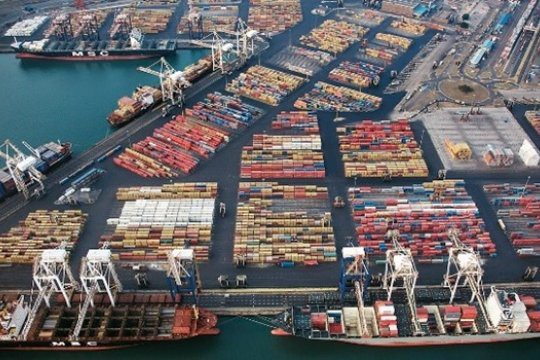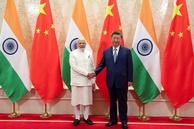Picture: maritime-executive.com
Over the years, the competition between the great powers in the dual space of the Indian and Pacific Oceans has been rapidly increasing. In the face of the aggravation of relations between the PRC and the United States, the defence dimension of the rivalry between the two contenders for global leadership traditionally comes to the forefront. However, in today's context, the parties will most likely not engage in military action for the strengthening of their dominance in the region, but they will try to achieve the goals by expanding of economic influence. In this context, along with the well-known trade wars, there is an infrastructure rivalry in the region, which is enforced on Beijing by Washington and the Quadrilateral Security Dialogue (Quad).
The role of Infrastructure in Indian and Pacific Oceans’ countries
The countries of Asia traditionally drawing the attention of the world community due to the high rates of economic, technological, and social development. In less than three decades, their per capita income has increased by 74%, millions of people have been lifted out of poverty, as well as a growing middle class has emerged in the region. [1] All this became possible due to the multilateral cooperation institutionalization and the integration of the economies of the Indo-Pacific. However, the strengthening of trade and economic ties and the future prosperity of Asia largely depends on the infrastructure (ports, highways and railways, airports, pipelines, etc.), which contributes to a more active movement of goods on a regional and global scale. Moreover, back in 2009, the Asian Development Bank (ADB) published a report according to which collective investments in infrastructure in the amount of US$8 trillion will be required to maintain rapid economic growth in Asian countries.[2]
The most prominent infrastructure initiative in recent years is the «Belt and Road Initiative» (BRI), which was launched by China's leader Xi Jinping in 2013. The BRI helped to fill numerous infrastructure gaps, but the United States and its partners increasingly paid attention to the geostrategic aspect of China's actions. It's no secret that the Belt and Road plays an important role in the development and integration of China's provinces with neighboring countries. However, with the growing number of countries participating in the BRI, as well as the strengthening of China's influence on a regional and global scale, criticism of the strategic tools for expanding Beijing's economic influence gradually increased. The Belt and Road has faced a number of critical remarks, including those related to accusations of purposely involving the regional countries in the so-called «debt traps». Regardless of the degree of truthfulness or study of the issue, from year to year, media reports have contributed to the building of a contradictory attitude to China's BRI among the residents, experts, and political elites all over the world.
Moreover, as soon as Donald Trump became the U.S. President in early 2017, Washington modified the nature of its policy towards China to greater confrontation. This trend has become a direct expression of the intensified great powers' rivalry and their struggle for hegemony in the Indo-Pacific, as well as a motivation for the revival of the Quadrilateral Security Dialogue (Quad), which includes the United States, Australia, India and Japan. However, the interaction of the Quad has long been built on the basis of defence.
This trend continues nowadays, as evidenced by the frequent exercises and the growing Quad naval presence in the Indo-Pacific but in 2021 the Quad countries expanded their range of issues on a multilateral basis. Now the agenda includes vaccine diplomacy (providing 1 billion COVID-19 vaccines to Indo-Pacific countries, climate change, technological cooperation, maritime security, cybersecurity, and external development assistance. According to Kurt Campbell, Indo-Pacific policy coordinator at the National Security Council, Washington is looking to convene an in-person fall summit of leaders of the Quad countries with a focus on infrastructure in the face of the challenge from China.[3]
Quadrilateral infrastructure diplomacy as the continuing vector of the Trump’s administration
The infrastructure agenda also became an important part of the last summit of the G7 countries' leaders, during which the parties expressed their willingness to establish a BRI counterpart called Build Back Better World (B3W). In total, there are 22 mentions of infrastructure in the final G7 Summit Communiqué.[4] Even despite the traditionally restrained position of India, which took the time to «study the specifics of the proposal»[5], infrastructure diplomacy of Quad is becoming a new area of geostrategic competition in the Indo-Pacific.
There's one exception: the activities on the infrastructure track are not a new trend of U.S. President Joe Biden's administration, but a continuation of the foreign policy vector set during the presidency of Donald Trump. It was he who turned Sino-U.S. rivalry into a geo-economic level. Back in 2017, the Foreign Ministers of the Quad countries stated the need for high-quality infrastructure development in order to ensure freedom and openness of sea routes, as well as improve intra-regional ties. In 2018, MoU was signed between the US Overseas Private Investment Corporation (OPIC), the Japan Bank for International Cooperation (JBIC) and the Ministry of Foreign Affairs and Trade of Australia, aimed at implementing major infrastructure projects in the Indo-Pacific.[6] Moreover, the Quad countries raised the question of the BRI countries' growing debt during their official meeting in Singapore.
It was clear that the Belt and Road Initiative is perceived by the Quad countries as the main factor in expanding the economic and political influence of the People's Republic of China, as well as China's influence of the domestic political processes in the countries of Indo-Pacific. At the same time, the combination of economic and defence rivalry enforced on Beijing by Washington, as well as Quad's efforts to build a balance of power in the region actually indicates the explicit anti-China nature of the Quad.
In this case, it's important to note that each of the Quad countries has its own levers of influence, which they can combine in infrastructure competition with Beijing. For example, in 2015, in response to the implementation of the Belt and Road Initiative and the establishment of the Asian Infrastructure Investment Bank (AIIB) by China, Japan made the Partnership for Quality Infrastructure (PQI). The United States, in turn, announced the infrastructure project Blue Dot Network (BDN), as well as the Ministry of Foreign Affairs and Trade of Australia established a new Partnerships for Infrastructure (P4I). All these initiatives are united by a commitment to inclusive economic growth, «quality infrastructure», climate change, disaster response, and social development. The capitalization of the Japanese, American and Australian initiatives is US $110 billion (US$50 billion from Japan and over US$50 from the Asian Development Bank)[7], US$30-60 million[8], and US$383 thousand (including access to US$4 billion of foreign aid and $US2 billion from the Australian Infrastructure Financing Facility for the Pacific)[9], respectively. Given the ongoing discussions about debt traps, the emphasis on «high-quality infrastructure» may give special features to the initiatives of the Quad but even the total amount of funding will not be able to compete with the US$770 billion investments already made in 138 countries of the world and announced by China.
Anyway, Quad is stepping up its infrastructure diplomacy in at least three areas, including Southeast Asia, Oceania, and the Indian Ocean. For example, Australia, Germany and Switzerland have already allocated US$13 million to the Mekong River Commission For Sustainable Development (MRC) to assist Cambodia, Laos, Thailand and, Vietnam «to respond to pressing challenges while safeguarding the ecological function of the Mekong River and improving people’s livelihoods».[10] At the same time, Australia signed US$300 million MoU with Papua New Guinea, aimed at the ports reconstruction in the major state of Oceania (the ports of Vanimo, Kimbe, Motukea, Lorengau, Oro Bay, Daru, Lae, etc.).[11] It is important to highlight that the increasing economic and infrastructural presence of China in the countries of Oceania, energize Australia's policy in the South Pacific, which is a traditional zone of influence of Canberra. At the same time, the expansion of Australia's aid and investment to the broader Indo-Pacific is due to the commitment of the current Australian government to the U.S. foreign policy.
In turn, the reaction of the Southeast Asian countries to the intensification of Quad infrastructure diplomacy will be more restrained. According to the latest Pew Research Center survey, the most unfavourable view of China is in the United States (76%), Canada (73%), Germany (71%), Japan (88%), Australia (78%), and South Korea (77%), while in Singapore — the only country representing ASEAN in the survey — the percentage of unfavourable views on China is at a low level (34%).[12] Moreover, considering the aspects of infrastructure diplomacy in the region, we should definitely refer to the survey of the Center for Strategic and International Studies (CSIS) of the political elites of the region «Powers, Norms, and Institutions: The Future of the Indo-Pacific from a Southeast Asia Perspective», published in 2020. Despite the intentional exclusion of Russia from the survey, it approximately reflects the trends in the Indo-Pacific countries at the present stage. Thus, as a result of the survey, American experts revealed that the political elites of Southeast Asia positively assess China's activities in the field of infrastructure development, which has brought tangible benefits to most Southeast Asian countries.[13]
Beijing's Response
China is actively reacting to verbal attacks from the United States and Quad. The infrastructure agenda was no exception, but China responded by modernizing its global Belt and Road Initiative. In response to criticism about the involvement of the countries in debt traps, Beijing has developed a new Foreign Policy White Paper «China's International Development Cooperation in the New Era». The document was published in early 2021. According to the provisions of the new White Paper, China will pay closer attention to the process of implementing projects within the aid framework, take an active part in evaluating projects in order to monitor their quality, maintain an appropriate level of confidence in its projects to China, as well as conduct bilateral consultations to identify difficulties with debt repayment and make sure that partners do not fall into a debt trap.[14] It’s possible that the new vision of the PRC will appear especially quickly in countries where the Quad will primarily try to implement their infrastructure projects.
China is the first country in the region, which pays significant attention to the issues of large-scale infrastructure development. Moreover, Beijing has a number of advantages over its opponent — Quad. First, the Belt and Road initiative is more structured and aimed at intensifying trade, economic, cultural and humanitarian cooperation with neighboring countries, while the emerging Quad infrastructure agenda is «dispersed» among numerous individual initiatives, doesn't have the same level of stability as the BRI, and even after 3.5 years of building the agenda is considered through the prism of expectations.
Second, China's initiative is aimed at a single infrastructure connection between the PRC and the rest of the world and acts as a potential basis for the intensification of global trade in the future. At the same time, today's projects of the Quad are of a “sporadic» nature and can't contribute to the infrastructure linkage between Europe, Africa, South and Southeast Asia on a global scale.
Third, China can already offer the Belt and Road members not only logistics infrastructure but also the opportunities in the field of green energy. At the end of 2019, China produced about a third of the world's solar energy and retained a leading position in the number of wind turbines. Within the foreseeable future, the Quad countries, and especially the United States, will have to compete with China even in the field of the climate agenda, which is so close to the new administration of the U.S. President Joe Biden.
Finally, during his recent speech on the occasion of the 100th anniversary of the Chinese Communist Party (CCP), PRC's Leader Xi Jinping confidently declared the great revival of the Chinese nation, its contribution to the progress of human civilization, and its readiness to build a new world, which undoubtedly indicates China's decisiveness to respond to challenges to its address, including from the Quad.
Conclusion
The ongoing transformation of the regional architecture in the Indo-Pacific, both in the defence and economic areas, will be an important aspect in the post-pandemic era. China has repeatedly stated about the «covered» Quad activities to deterrence Chinese policy in the region, but the expansion of the Quad's agenda by infrastructure diplomacy allows us to speak about the evident vector of the Quad strategy against the PRC.
However, nowadays the Quad countries had been left behind. China already has the world's most numerous land forces, the largest navy, as well as an ambitious global Belt and Road initiative that includes almost 140 countries and a capitalization approaching US$1 trillion. Of course, Quad is moving towards the institutionalization of its infrastructure cooperation and the potential expansion of the number of participating countries to the Quad Plus format. However, to reach China's achievements for the period 2013-2021, the new alliance will need at least a decade.
At the same time, the rivalry of the Belt and Road with the Quad's infrastructure initiative will help the countries of the region to diversify their infrastructure ties but will make their choice even more difficult, since it will primarily be regarded as support for the foreign policy vision of one of the parties, and not a pragmatic estimate of economic benefits. All this makes the regional environment in the Indo-Pacific increasingly complex and forces middle powers and smaller countries to adapt to new geostrategic realities.
[1] Achievements and Benefits // Asia-Pacific Economic Cooperation. URL: https://www.apec.org/about-us/about-apec/achievements-and-benefits
[2] Campbell, Kurt. (2016). “The Pivot: The Future of American Statecraft in Asia”, Twelve. Hachette Book Group. P. 76.
[3] U.S. says looking at Quad meeting in fall focused on infrastructure // Reuters. URL: https://www.reuters.com/world/us-says-looking-quad-meeting-fall-focused-infrastructure-2021-05-26/
[4] Carbis Bay G7 Summit Communiqué // The White House. URL: https://www.whitehouse.gov/briefing-room/statements-releases/2021/06/13/carbis-bay-g7-summit-communique/
[5] G7 infrastructure plan may not match up with India’s goals // Global Times. URL: https://www.globaltimes.cn/page/202106/1226219.shtml
[6] Joint Statement of the Governments of Australia, Japan and The United States // Prime Minister of Australia. URL: https://www.pm.gov.au/media/joint-statement-governments-australia-japan-and-united-states
[7] Partnership for Quality Infrastructure // Ministry of Foreign Affairs of Japan. URL: https://www.mofa.go.jp/files/000117998.pdf
[8] Washington Slow to Connect Its Blue Dot Network // Geopolitical Monitor. URL: https://www.geopoliticalmonitor.com/washington-slow-to-connect-its-blue-dot-network/
[9] Partnerships for Infrastructure DFAT // Style International: https://www.sitradingme.com/xem4yf/archive.php?page=partnerships-for-infrastructure-dfat
[10]Australia, Germany, Switzerland to provide nearly USD13 million to improve the Mekong River Basin’s overall state // Mekong River Commission for Sustainable Development. URL: https://www.mrcmekong.org/news-and-events/news/pr-24june2021/
[11] K1 Billion for Ports // LoopPNG. URL: https://www.looppng.com/png-news/k1-billion-ports-101714
[12] Large Majorities Say China Does Not Respect the Personal Freedoms of Its People // Pew Research Center. URL: https://www.pewresearch.org/global/2021/06/30/large-majorities-say-china-does-not-respect-the-personal-freedoms-of-its-people
[13] Powers, Norms, and Institutions: The Future of the Indo-Pacific from a Southeast Asia Perspective, 2020 // Center for Strategic and International Studies, CSIS. URL: https://csis-website-prod.s3.amazonaws.com/s3fs-public/publication/20624_Green_PowersNormsandInstitutions_WEB%20FINAL%20UPDATED.pdf
[14] China's International Development Cooperation in the New Era // XinhuaNet. URL: http://www.xinhuanet.com/english/2021-01/10/c_139655400.htm
read more in our Telegram-channel https://t.me/The_International_Affairs

 13:03 12.07.2021 •
13:03 12.07.2021 •



























